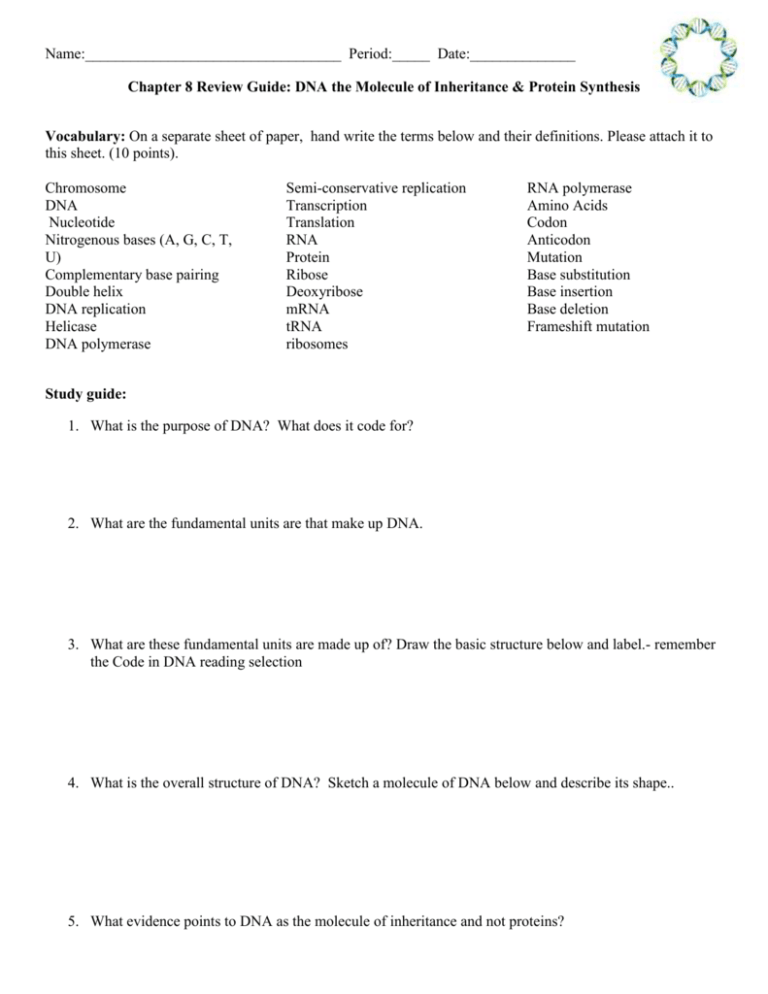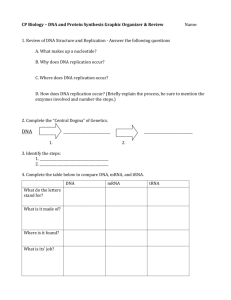File
advertisement

Name:__________________________________ Period:_____ Date:______________ Chapter 8 Review Guide: DNA the Molecule of Inheritance & Protein Synthesis Vocabulary: On a separate sheet of paper, hand write the terms below and their definitions. Please attach it to this sheet. (10 points). Chromosome DNA Nucleotide Nitrogenous bases (A, G, C, T, U) Complementary base pairing Double helix DNA replication Helicase DNA polymerase Semi-conservative replication Transcription Translation RNA Protein Ribose Deoxyribose mRNA tRNA ribosomes RNA polymerase Amino Acids Codon Anticodon Mutation Base substitution Base insertion Base deletion Frameshift mutation Study guide: 1. What is the purpose of DNA? What does it code for? 2. What are the fundamental units are that make up DNA. 3. What are these fundamental units are made up of? Draw the basic structure below and label.- remember the Code in DNA reading selection 4. What is the overall structure of DNA? Sketch a molecule of DNA below and describe its shape.. 5. What evidence points to DNA as the molecule of inheritance and not proteins? 6. Use the experiments from the following scientists to support the claim that DNA, not protein is the molecule of inheritance: a. Griffith a. Hershey and Chase b. Rosalind Franklin c. Watson and Crick 7. What is meant by complimentary base pairing? 8. What are Chargaff’s rules? What evidence from the analysis of species DNA supports this rule? 9. Below is a double strand of DNA. In the space below explain using a labeled drawing how DNA replicates itself semi-conservatively. Use two different colors, one for the parent or template strand and one for the daughter strand . By the way, what is meant by the semi-conservative model of replication? Include the following terms in your drawing: template or parent strand, daughter strand, DNA polymerase, ligase, helicase, leading strand, lagging strand and 3’and 5’ end. TACAAGCCGGTAAAACCTGAGATT I I I I I I I I I I I I I ATGTTCGGCCAT T TTGGACTCTAA I= hydrogen bond 10. What were the limitations of the paperclip model you made to simulate the replication of DNA? 11. How could the modeling activity be improved to more accurately explain how DNA is able to replicate itself? 12. Where does DNA replication occur in the cell? 13. Why is DNA replication important during mitosis? 14. In what stage of the cell cycle (during cell division) does DNA replication happen? 15. Name at least four examples of proteins? Address each of the questions relating to each protein: a. Why is this protein important for maintaining life? b. Where is this protein found? c. What are their biological functions? 16. Why are very different substances such as hormones and the components of spider silk both classified as proteins? 17. What are the building blocks (monomers) of proteins? How many kinds of these building blocks are there? What makes each type unique? 18. Create a Venn diagram below to show the similarities and differences between RNA and DNA. 19. What is protein synthesis? 20. What molecules are involved in this process? 21. Create a Venn diagram below to compare and contrast DNA transcription and replication. 22. In the modeling activity you did with paperclips for the process of transcription, you transcribed a section of the gene for making hemoglobin. This is a very short section of that gene. Each one was only 10 nucleotides long. How many different arrangements of nucleotides are possible in a segment of DNA that is 10 nucleotides long? 23. What is the product of DNA transcription? 24. What is the product of DNA translation? 25. Transcribe the TOP strand of the DNA molecule you replicated in problem #9 below: (i.e. make mRNA) 26. Now use your genetic code breaker to translate the mRNA from above: 27. Describe the process of translation below. In your explanation be sure to use the terms mRNA, codons, anticodons, tRNA, ribosome, amino acids and protein. Where does this process occur? A C E B D 28. In the picture above, label the molecules A – E. 29. If the codon on the mRNA reads AAA, what is the anticodon on the tRNA? a. What amino acid will be brought in? 30. What are mutations? 31. How do they occur? 32. What sorts of things cause mutations? 33. What is the least harmful type of mutation? What about the most harmful type of mutation? 34. Why are mutations in gametes different than mutations in somatic(body) cells? 35. Why does each new cell carry a mutation from the original cell? 36. How do mutations relate to the evolution of a species? Give an example to illustrate this process. 37. How might variability within a population help that population survive? 38. Here is the DNA strand from #9. A nucleotide base has been inserted in the top strand where the arrow is. How does this affect the protein made? Transcribe the DNA (top strand), and then translate it into protein. TACAAGTCCGGTAAAACCTGAGATT ATGTTCGGCCAT T TTGGACTCTAA mRNA: __________________________________________________ Amino Acid Sequence:________________________________________________ What affect do you think this mutation will have on the protein? Explain. 39. What were some (at least 3) of the major findings from the mapping of the human genome? 40. How many arrangements of nucleotides are possible if you take 4 nucleotides.. two at a time?… three at a time?.. one at a time?.. 41. Why do scientists think that the genetic code is read as a triplet code? Explain your answer.. 42. In your own words, or in a diagram such as a concept map, briefly describe the relationship among nucleotides, DNA, genes, chromosomes, nucleus, cells and traits in an organism. 43. From studying the genetic code of various organism, construct a family tree (cladogram) 44. How can DNA be used for evidence for common ancestry? 45. How can DNA evidence be used to support the theory of evolution?








